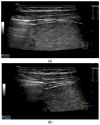The Perception of the Diaphragm with Ultrasound: Always There Yet Overlooked?
- PMID: 40003648
- PMCID: PMC11857681
- DOI: 10.3390/life15020239
The Perception of the Diaphragm with Ultrasound: Always There Yet Overlooked?
Abstract
Diaphragm ultrasound makes it possible to diagnose diaphragmatic atrophy and dysfunction. Important indications include unclear dyspnea; diaphragmatic elevation; assessment of diaphragm dysfunction in pulmonary, neuromuscular and neurovascular diseases; and in critically ill patients before noninvasive and mechanical ventilation and follow-up of diaphragm thickness and function during mechanical ventilation with potential prediction of prolonged weaning. In patients with respiratory insufficiency and potential diaphragm dysfunction, it is possible to objectify the contribution of diaphragm dysfunction. In addition, assessment of diaphragmatic hernias, tumors and diaphragmatic dysfunction in COVID-19 and diaphragmatic ultrasound in sports medicine have been described. This narrative review includes the sonomorphology of the diaphragm, standardization of ultrasonographic investigation with transducer positions and ultrasound techniques, normal findings and diagnostic criteria for pathological findings. The correct sonographic measurement, calculation and evaluation can ultimately influence further therapeutic procedures for the patient suffering from diaphragm dysfunction in various diseases.
Keywords: amplitude; diaphragm dysfunction; diaphragm thickening fraction; diaphragm thickness; ultrasonographic diagnosis.
Conflict of interest statement
The authors declare that they have no financial conflict of interest with regard to the content of this report.
Figures

















Similar articles
-
Ultrasound assessment of ventilator-induced diaphragmatic dysfunction in mechanically ventilated pediatric patients.Paediatr Respir Rev. 2021 Dec;40:58-64. doi: 10.1016/j.prrv.2020.12.002. Epub 2021 Feb 23. Paediatr Respir Rev. 2021. PMID: 33744085 Review.
-
A narrative review of diaphragm ultrasound to predict weaning from mechanical ventilation: where are we and where are we heading?Ultrasound J. 2019 Feb 28;11(1):2. doi: 10.1186/s13089-019-0117-8. Ultrasound J. 2019. PMID: 31359260 Free PMC article. Review.
-
Sensitivity and specificity of diagnostic ultrasound in the diagnosis of phrenic neuropathy.Neurology. 2014 Sep 30;83(14):1264-70. doi: 10.1212/WNL.0000000000000841. Epub 2014 Aug 27. Neurology. 2014. PMID: 25165390 Free PMC article.
-
Diaphragmatic Dysfunction Is Characterized by Increased Duration of Mechanical Ventilation in Subjects With Prolonged Weaning.Respir Care. 2016 Oct;61(10):1316-22. doi: 10.4187/respcare.04746. Respir Care. 2016. PMID: 27682813
-
Ultrasound assessment of diaphragmatic dysfunction in non-critically ill patients: relevant indicators and update.Front Med (Lausanne). 2024 Jun 18;11:1389040. doi: 10.3389/fmed.2024.1389040. eCollection 2024. Front Med (Lausanne). 2024. PMID: 38957305 Free PMC article. Review.
Cited by
-
Pulmonary function prediction in lung cancer resection candidates: the latest insights.Breathe (Sheff). 2025 Jul 15;21(3):250041. doi: 10.1183/20734735.0041-2025. eCollection 2025 Jul. Breathe (Sheff). 2025. PMID: 40673067 Free PMC article.
-
Ultrasound of the Gallbladder-An Update on Measurements, Reference Values, Variants and Frequent Pathologies: A Scoping Review.Life (Basel). 2025 Jun 11;15(6):941. doi: 10.3390/life15060941. Life (Basel). 2025. PMID: 40566593 Free PMC article. Review.
References
-
- Spiesshoefer J., Herkenrath S., Henke C., Langenbruch L., Schneppe M., Randerath W., Young P., Brix T., Boentert M. Evaluation of Respiratory Muscle Strength and Diaphragm Ultrasound: Normative Values, Theoretical Considerations, and Practical Recommendations. Respiration. 2020;99:369–381. doi: 10.1159/000506016. - DOI - PubMed
-
- Haaksma M.E., Smit J.M., Boussuges A., Demoule A., Dres M., Ferrari G., Formenti P., Goligher E.C., Heunks L., Lim E.H.T., et al. EXpert consensus On Diaphragm UltraSonography in the critically ill (EXODUS): A Delphi consensus statement on the measurement of diaphragm ultrasound-derived parameters in a critical care setting. Crit. Care. 2022;26:99. doi: 10.1186/s13054-022-03975-5. - DOI - PMC - PubMed
Publication types
LinkOut - more resources
Full Text Sources

